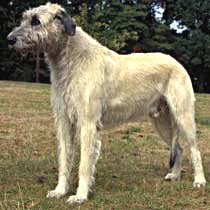|
The Canine Chronicles Directory
Irish Wolfhound

The Irish Wolfhound is the tallest breed in the world. When fully grown and standing
on their hindlegs, many can reach over 7 feet tall. They can be the same size as
a small pony. The rough, coarse coat is wiry over the eyes and jaw. The coat color
is grey, steel gray, brindle, red, black, white, fawn or wheaten. They should have
a large head with an elongated muzzle. The oval eyes should be dark and the strong
jaw should have teeth meeting in a scissor-like bite. The lips and nose are both
black. The small, rose-shaped ears should be dark and hang away from the face. The
muscular neck should be extended and well-arched. The back should be long, the chest
deep and the abdomen well drawn up. The muscular legs should be strong and straight.
The large round feet should have well arched toes. The long tail is slightly curved
and covered with hair.
|
|
Temperament
|
Irish Wolfhounds are gentle, reliable, patient, loyal, generous and affectionate.
They are unconditionally devoted to their families. They are excellent with children.
Irish Wolfhounds should be supervised around smaller children since they can forget
how big they are when playing with children. They are also great with other dogs
as well as other household pets if raised with them. This breed is friendly with
visitors, greeting them warmly. They physically grow very rapidly; however, they
usually take almost two years before they are mentally fully mature. While they
are puppies, allow them to set the exercise pace. Overexerting this breed during
their development stage, may cause harm. Due to their temperaments, they are not
natural guard dogs. Nonetheless, their size alone is a great deterrent against strangers.
|
|
Height, Weight
|
Height: 28-35" ; Weight: 90-150 lbs.
|
|
Health Problems
|
The Irish Wolfhound is prone to bone cancer, bloat, PRA, Von Willebrands, cardiomyopathy
and hip dysplasia.
|
|
Living Conditions
|
These giant dogs should not live in an apartment. They do best with a large yard.
You must have lots of room in your heart, home, yard and car for this huge dog.
You should never put this breed in a kennel as they love to be with their family
at all times. Being sight-hounds, they will chase, so make sure they are on a secure
lead or in a secure yard.
|
|
Exercise
|
Irish Wolfhounds have lots of energy and need lots of space to run. They love to
go for long walks with their family. Allow puppies to decide how much exercise they
need as too much at a young age is not good for their development.
|
|
Life Expectancy
|
About 6-8 years
|
|
Grooming
|
This breed needs regular and thorough brushing and combing. Pluck the coat about
once or twice a year to remove dead hair. They are average shedders.
|
|
Origin
|
In 275 BC, the Celts invaded Greece. While there, they acquired dogs (similar to
greyhounds) that accompanied them throughout their European conquests. Once the
Celts returned to their homeland, these dogs were believed to have been crossed
with the Cu ? a mastiff type dog. During the Roman invasion of Britain in the early
centuries AD, these dogs were found and exported. Ancient Irish stories detailed
a 'Great Irish Hound' and dated the dog's existence in that region between 200 BC
and 200 AD. Written records have been found from the 5th century detailing the organized
breeding and profitability of a dog that resembled the wolfhound type. The breed
was so profitable that they were sold to other countries in addition to being given
as gifts to royal monarchs. Irish Wolfhounds were used for battle, guarding, and
hunting large game, including boar, stag, elk and wolf. During the 15th and 16th
centuries the breed was mainly used for hunting wolves in the British Isles. In
the mid 1600s, this breed was a very popular export, however wolves were still a
large problem. Due to this, Oliver Cromwell banned the exportation of the breed.
In 1780, once the last wolf was allegedly killed in Ireland, the breed numbers began
to dwindle. During the Great Famine of the 1840s, people were unable to feed this
large breed, causing them to come very close to extinction. In the late 1800s Captain
George A. Graham decided to restore the breed to its ancient type and dedicated
his life towards this pursuit. The Irish Wolfhound was bred with Deerhounds and
sporadically crossed with Borzoi and Great Dane. They were first shown in the 1870s
and by the end of the 1800s they were making a slow comeback. They are recognized
by the AKC and the UKC.
|
|
Group
|
AKC Hound, UKC Sighthound and Pariah Dog
|